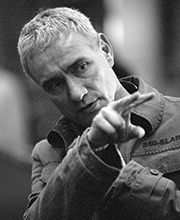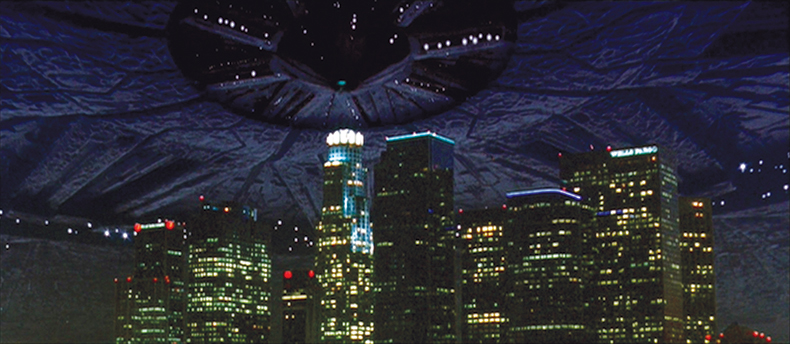By Jeffrey Ressner
 Delivering a new spin on the disaster films of the 1970s—only this time revolving around an alien invasion of the entire planet—Roland Emmerich’s Independence Day (1996) broke new visual ground by compositing miniatures with CG elements and live action. Most of the effects were accomplished by exploding models, and the film still holds the record for the most miniatures to appear in one picture.
Delivering a new spin on the disaster films of the 1970s—only this time revolving around an alien invasion of the entire planet—Roland Emmerich’s Independence Day (1996) broke new visual ground by compositing miniatures with CG elements and live action. Most of the effects were accomplished by exploding models, and the film still holds the record for the most miniatures to appear in one picture.
Emmerich gladly admits that he was hugely influenced by Steven Spielberg and James Cameron. “I love their work. Close Encounters of the Third Kind is probably my all-time favorite. I think that shows in my films, but also I wasn’t saying, ‘Ooh, let’s do this, let’s do that because they did it.’”
Collaborating with a veteran effects team, Emmerich created many of the film’s most forceful images without a script, relying on various ideas in his mind’s eye about what would frighten an audience. In this sequence, after flying saucers arrive and ominously circle the Earth, the scene climaxes with the splinter-shattering destruction of some of the country’s most iconic landmarks, including the First Interstate Bank Center in Los Angeles, the Empire State Building, and finally the White House, which became the image for the film’s worldwide marketing campaign.
“20th Century Fox was very nervous about putting something like this in the teaser,” recalls Emmerich. “I kind of insisted on it, because it was the signature of the film. I wanted to have one or two sequences that people hadn’t seen before and were amazed by.”

This is a destroyer ship over Los Angeles above the First Interstate Bank Tower, the tallest building in California. It’s the culmination of the movie up until this point. The audience doesn’t know exactly what these large alien ships are going to do. I wanted to look out of my window in LA or New York or anywhere and see the underbelly of a ship that size in every major city of the world. I argued that in other movies the attacks came from small flying saucers, and it didn’t make any sense to me. This was filmed at a time when most effects work was still done with models. We used digital elements in compositing and had a couple of CG shots, but it was an odd time and digital effects had really just started.

The ship’s lower dome is opening above Los Angeles, where a group of about 100 crazy people have moved out to welcome the arrivals. Los Angeles was shot as a real plate so we could make a matte. We shot at magic hour; I think it was on a Sunday. It was pretty open and we could shoot whatever we wanted. The LA scenes were shot outside, but some of them look like interiors because of the light of the fire. Here and in shot 4 in New York you can see the smaller models begin to open to expose the laser beams.

This is the Empire State Building. We only shot in New York for a couple of days because of our budget. We had a discussion about what buildings in what towns we would use, and in New York it was clear it was the Empire State Building. Things were getting very complicated by this point. We had blue screen, the models, and 11 other various elements. The model of the Empire State Building was maybe 12 feet tall.

We had three different-size models of the spaceship. We had really small ones for the wide shots and then we had one for underbelly shots which was around 12 feet wide, and then we had a bigger model with a bigger scale for the middle part of the ship which is starting to open in this shot above the Empire State Building. It’s a 12-foot, highly mechanized model, so everything is being driven automatically. The smoky effect of the alien spacecraft as it moves into position above New York City was created by a double exposure on the film. It came from recording water in a tank turning murky after a clod of dirt was dropped into it.

This is a crane shot of the traffic jam. Everybody’s a little bit panicked because all of a sudden they have a roof over their heads. They’re stuck in traffic minutes from when the destruction starts. This was shot outside in downtown LA. That’s where we did all the close stuff that we needed with people. This was an image I always had in my head. It was a wave, a ring of fire with so much force that cars get flipped. We had ratchets that flipped the cars. [For the studio part of the shot], we used these little model cars and would create the feeling of air pressure and fire coming toward the audience.

We did this shot of the White House exploding at 3 in the morning. It was a model 5 feet high and about 14 feet wide and had been built on a bluff near the soundstages at the old Hughes Aircraft [in Playa Vista]. Pyrotechnics supervisor Joe Viskocil attached 30 to 40 explosive charges at key points around the model. We shot with nine cameras filming at various speeds, then played back at normal speed to make the explosion seem larger and slower. The model itself was packed with pieces of dollhouse-size furniture so the debris coming out would look like real objects—wooden chairs, desks, paintings, dresses—even a toilet. There’s nothing better than blowing up a big model; you can’t create that with CGI.

This is Air Force One with the president on board escaping from Washington. It was a simple shot with three things to composite together: Fire, the plane, and the city. The city was seen through a black screen with some holes in it. The plane going down the runway engulfed in flames is a miniature. Some motion control shots of flames chasing the plane and different fire elements were composited on top of each other to make it look threatening. I did tiny little fire elements on top of the composited shot because, at this point, you couldn’t do fire with digital or computers yet. You could create something very similar to fire, but that never looked real, so we downsized real fires and put them on top.

This model shot of the tunnel is one of my favorites. It was complicated to do because, first of all, we had to build the model of the tunnel and there are so many elements in this one shot. We did something that we did with a lot of these shots, which was having the fire coming toward you. Fire is hot and wants to go up; it’s a chimney effect. So we turned all these streets or the tunnel sideways so they were standing vertically. And because of that it looks like the fire and heat are rolling toward the camera. For shots where cars are bouncing off the ceiling, sometimes we used a Plexiglas ceiling with a blue screen behind it and let the cars bounce against it.

This was actually shot in the Second Street Tunnel in Los Angeles. Vivica Fox played the stripper girlfriend of Will Smith. It’s clearly a bombastic, classic film moment in which she faces being crushed by the crowd. Instead, she ducks into a maintenance door and is saved. At first we had this whole sequence with music and it just didn’t want to work. So we tried it with just the fire effects and noises. And only when we cut to Vivica in the tunnel, then the music comes in. That ramps it up another notch, because before that you’re so taken by the sequence that you didn’t even notice there was no music, but then when the music comes in it gives you a real jolt.

Vivica realizes all of a sudden that her dog is not there and she calls for him, and the dog comes running to her and leaps over the flames and also makes it to safety. At the premiere, I think the biggest cheer I ever heard in a movie theater was when the dog jumps to safety. Hundreds of millions of people have died and the dog made it. Great! He was my favorite dog I’ve ever worked with. He was a super-trained golden Lab. A golden Lab is the best special-effects dog for your dollar. He’ll give you more energy and more action in less time than is humanly possible. So anytime you make an SFX film, be sure to use a golden Lab.